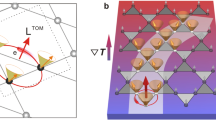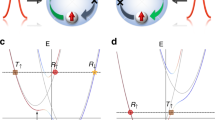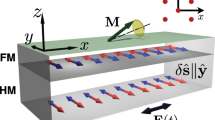Abstract
Spin currents—the flow of angular momentum without the simultaneous transfer of electrical charge—play an enabling role in the field of spintronics1,2,3,4,5,6,7,8. Unlike the charge current, the spin current is not a conservative quantity within the conduction carrier system. This is due to the presence of the spin–orbit interaction that couples the spin of the carriers to angular momentum in the lattice. This spin–lattice coupling9 acts also as the source of damping in magnetic materials, where the precessing magnetic moment experiences a torque towards its equilibrium orientation; the excess angular momentum in the magnetic subsystem flows into the lattice. Here we show that this flow can be reversed by the three-magnon splitting process and experimentally achieve the enhancement of the spin current emitted by the interacting spin waves. This mechanism triggers angular momentum transfer from the lattice to the magnetic subsystem and modifies the spin-current emission. The finding illustrates the importance of magnon–magnon interactions for developing spin-current based electronics.
This is a preview of subscription content, access via your institution
Access options
Subscribe to this journal
Receive 12 print issues and online access
$259.00 per year
only $21.58 per issue
Buy this article
- Purchase on Springer Link
- Instant access to full article PDF
Prices may be subject to local taxes which are calculated during checkout




Similar content being viewed by others
References
Maekawa, S. Concepts in Spin Electronics (Oxford Univ. Press, 2006).
Johnson, M. & Silsbee, R. H. Interfacial charge-spin coupling: Injection and detection of spin magnetization in metals. Phys. Rev. Lett. 55, 1790–1793 (1985).
Jedema, F. J., Filip, A. T. & van Wees, B. J. Electrical spin injection and accumulation at room temperature in an all-metal mesoscopic spin valve. Nature 410, 345–348 (2001).
Lou, X. et al. Electrical detection of spin transport in lateral ferromagnet-semiconductor devices. Nature Phys. 3, 197–202 (2007).
Yang, T., Kimura, T. & Otani, Y. Giant spin-accumulation signal and pure spin-current-induced reversible magnetization switching. Nature Phys. 4, 851–854 (2008).
Slachter, A., Bakker, F. L., Adam, J-P. & van Wees, B. J. Thermally driven spin injection from a ferromagnet into a non-magnetic metal. Nature Phys. 6, 879–882 (2010).
Saitoh, E., Ueda, M., Miyajima, H. & Tatara, G. Conversion of spin current into charge current at room temperature: Inverse spin-Hall effect. Appl. Phys. Lett. 88, 182509 (2006).
Kajiwara, Y. et al. Transmission of electrical signals by spin-wave interconversion in a magnetic insulator. Nature 464, 262–266 (2010).
Kittel, C. Introduction to Solid State Physics 7th edn (John Wiley, 1996).
Kato, Y. K., Myers, R. C., Gossard, A. C. & Awschalom, D. D. Observation of the spin Hall effect in semiconductors. Science 306, 1910–1913 (2004).
Wunderlich, J., Kaestner, B., Sinova, J. & Jungwirth, T. Experimental observation of the spin-Hall effect in a two-dimensional spin–orbit coupled semiconductor system. Phys. Rev. Lett. 94, 047204 (2005).
Takahashi, S. & Maekawa, S. Spin current, spin accumulation and spin Hall effect. Sci Technol. Adv. Mater. 9, 014105 (2008).
Gurevich, A. G. & Melkov, G. A. Magnetization Oscillations and Waves (CRC, 1994).
Sandweg, C. W., Kajiwara, Y., Ando, K., Saitoh, E. & Hillebrands, B. Enhancement of the spin pumping efficiency by spin wave mode selection. Appl. Phys. Lett. 97, 252504 (2010).
Kittel, C. On the theory of ferromangetic resonance absorption. Phys. Rev. 73, 155–161 (1948).
Tserkovnyak, Y. & Brataas, A. Enhanced Gilbert damping in thin ferromagnetic films. Phys. Rev. Lett. 88, 117601 (2002).
Tserkovnyak, Y., Brataas, A. & Bauer, G. E. Dynamic stiffness of spin valves. Phys. Rev. B 67, 140404 (2003).
Ando, K. & Saitoh, E. Inverse spin-Hall effect in palladium at room temperature. J. Appl. Phys. 108, 113925 (2010).
Demokritov, S. O., Hillebrands, B. & Slavin, A. N. Brillouin light scattering studies of confined spin waves: Linear and nonlinear confinement. Phys. Rep. 348, 441–489 (2001).
Ordóňez-Romero, C. L. et al. Three-magnon splitting and confluence processes for spin-wave excitations in yttrium iron garnet films: Wave vector selective Brillouin light scattering measurements and analysis. Phys. Rev. B 79, 144428 (2009).
Schultheiss, H. et al. Direct current control of three magnon scattering processes in spin-valve nanocontacts. Phys. Rev. Lett. 103, 157202 (2009).
Kalinikos, B. A. & Slavin, A. N. Theory of dipole-exchange spin wave spectrum for ferromagnetic films with mixed exchange boundary conditions. Physica C 19, 7013–7033 (1986).
Wigen, P. E. Nonlinear Phenomena and Chaos in Magnetic Materials (World Scientific, 1994).
Khitun, A., Bao, M. & Wang, K. L. Spin wave magnetic nanofabric: A new approach to spin-based logic circuity. IEEE Trans. Mag. 44, 2141–2151 (2008).
Einstein, A. & de Haas, W. J. Experimenteller Nachweis der Ampereschen Molekularstörme, Verhandlungen. Dtsch. Phys. Gesellschaft. 17, 152–170 (1915).
Bloch, F. Zur Theorie des Ferromagnetismus. Z. Phys. 61, 206–219 (1930).
Bloembergen, N. S., Shapiro, P. S., Pershan, O. & Artman, Cross-relaxation in spin systems. Phys. Rev. 114, 445–459 (1959).
Holstein, T. & Primakoff, H. Field dependence of the intrinsic domain magnetization of a ferromagnet. Phys. Rev. 58, 1098–1113 (1940).
Majlis, N. The Quantum Theory of Magnetism 2nd edn (World Scientific Publishing, 2007).
Sandweg, C. W. et al. Spin pumping by parametrically excited exchange magnons. Phys. Rev. Lett. 106, 216601 (2011).
Acknowledgements
The authors thank A. Slavin, E. Saitoh, K. Ando, K. Harii and Y. Tserkovnyak for their valuable discussions. H.K. is grateful to the Royal Society for their financial support via TG102227. S.O.D. acknowledges helpful discussions with B. Koopmans on the conservation of angular momentum in ferromagnets. Work in Münster has been supported by the Deutsche Forschungsgemeinschaft and by the European Union through the STREP Project Master NMP3-SL-2008-212257.
Author information
Authors and Affiliations
Contributions
Sample preparation: H.K., O.D. and D.F.; measurement and data analysis: O.D., H.K. and V.E.D.; interpretation and theoretical calculation: S.O.D. and H.K.; manuscript writing: S.O.D., H.K., V.E.D. and A.J.F. This project was initiated and managed by H.K. and S.O.D.
Corresponding author
Ethics declarations
Competing interests
The authors declare no competing financial interests.
Supplementary information
Supplementary Information
Supplementary Information (PDF 849 kb)
Rights and permissions
About this article
Cite this article
Kurebayashi, H., Dzyapko, O., Demidov, V. et al. Controlled enhancement of spin-current emission by three-magnon splitting. Nature Mater 10, 660–664 (2011). https://doi.org/10.1038/nmat3053
Received:
Accepted:
Published:
Issue Date:
DOI: https://doi.org/10.1038/nmat3053
This article is cited by
-
Resonant generation of propagating second-harmonic spin waves in nano-waveguides
Nature Communications (2024)
-
Dramatically Enhanced Spin Dynamo with Plasmonic Diabolo Cavity
Scientific Reports (2017)
-
Generation of megahertz-band spin currents using nonlinear spin pumping
Scientific Reports (2017)
-
Thermal spin transfer torque in Fe|Ag|YIG multilayers
Frontiers of Physics (2017)
-
Yttrium Iron Garnet Thin Films with Very Low Damping Obtained by Recrystallization of Amorphous Material
Scientific Reports (2016)



